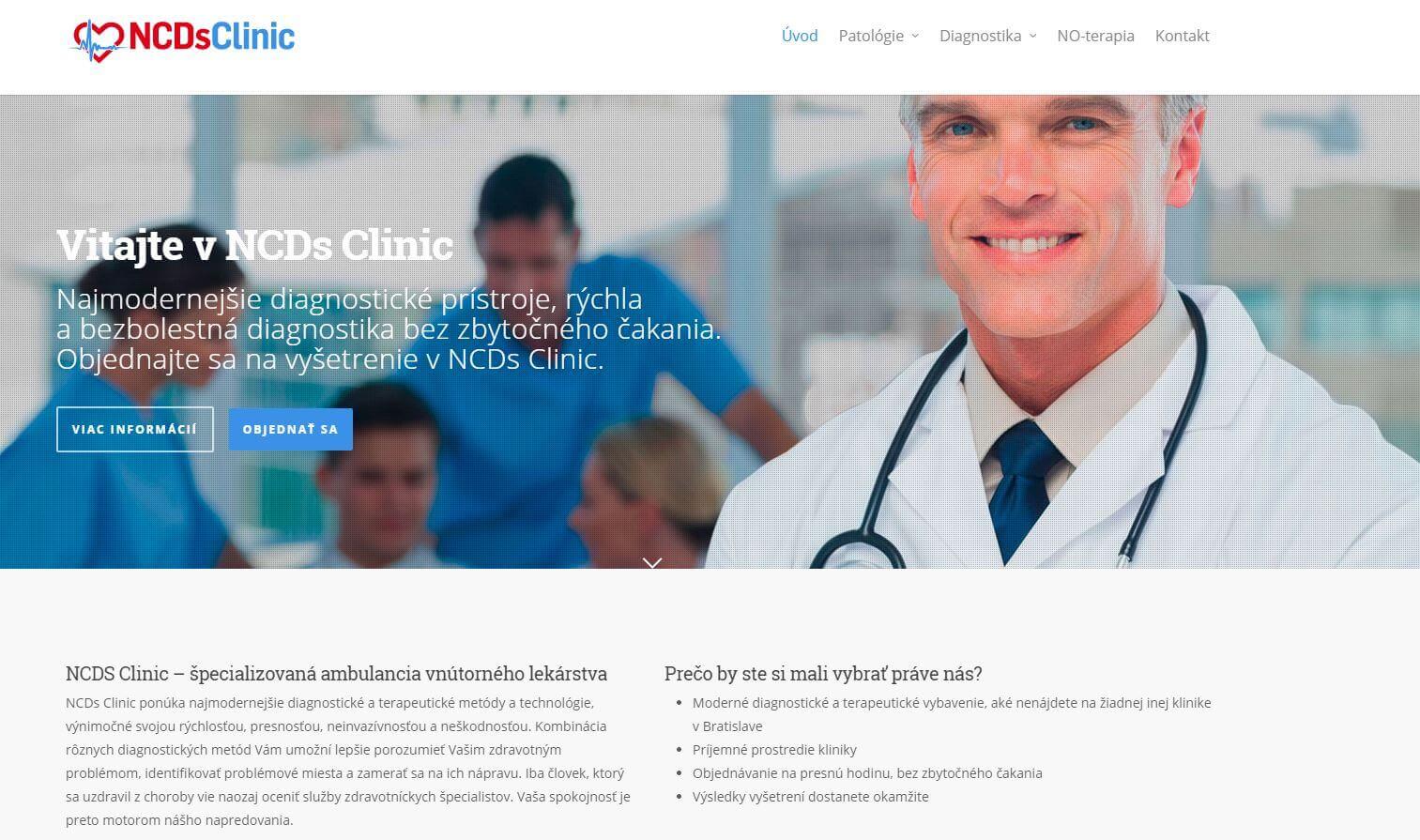Medical devices
search
news
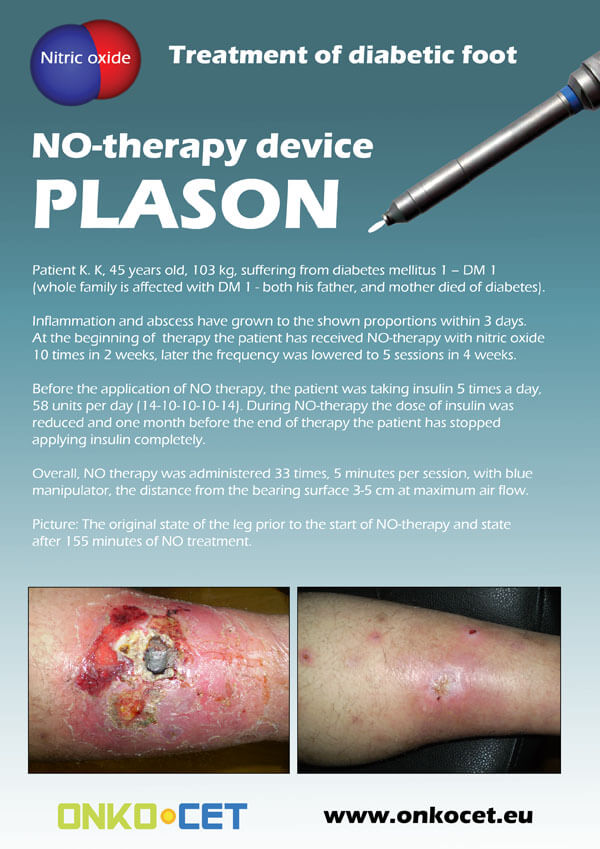
The PDF with the short report with pictures from the therapy of a diabetic foot can be viewed or downloaded here.
The pictures from the treatment of unhealing wounds an be found here:
http://www.onkocet.eu/en/produkty-detail/220/1/
The pictures from the treatment of unhealing wounds an be found here:
http://www.onkocet.eu/en/produkty-detail/293/1/
ONKOCET Ltd. has exhibited the devices from its portfolio on the MEDTEC UK exhibition in Birmingham, April 2011 through our partner Medical & Partners.
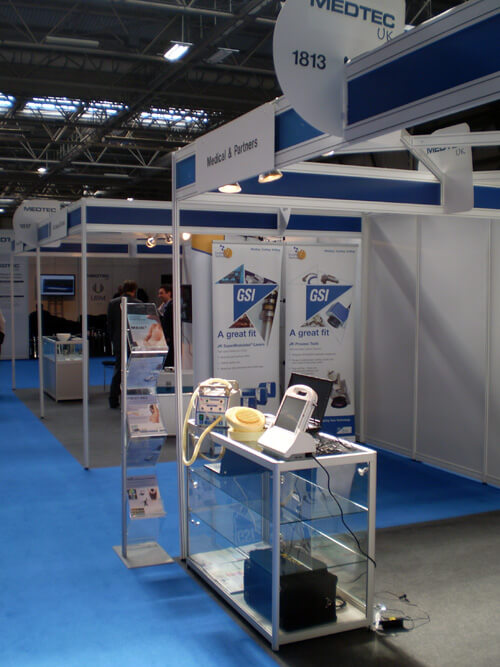
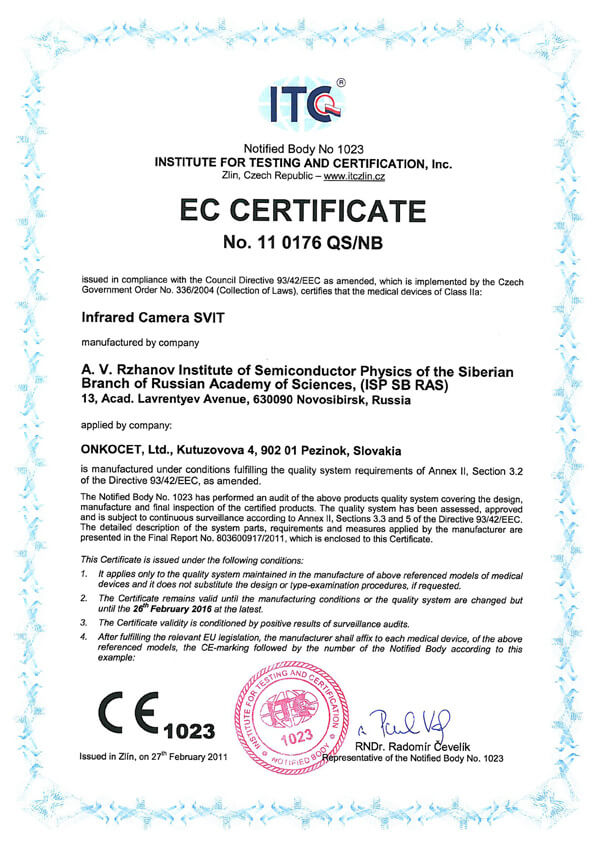 The ONKOCET company has successfully reached the certification of yet another medical device, Infrared Camera SVIT. The Certificate can be found here. The videos from the device operation can be found here.
The ONKOCET company has successfully reached the certification of yet another medical device, Infrared Camera SVIT. The Certificate can be found here. The videos from the device operation can be found here.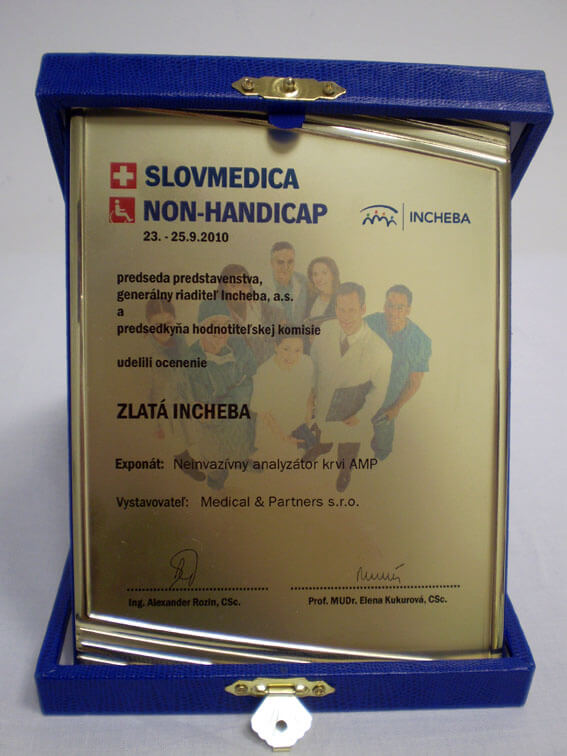 Our device, the non-invasive blood analyzer AMP has won the Golden Incheba prize at a medical exhibition SLOVMEDICA - NON-HANDICAP 2010. A big thank you goes to the organizers of the exhibition for acknowledging the quality of our device and to the exhibitor, the Medical & Partners company, for introduction of the AMP device to the medical public again.
Our device, the non-invasive blood analyzer AMP has won the Golden Incheba prize at a medical exhibition SLOVMEDICA - NON-HANDICAP 2010. A big thank you goes to the organizers of the exhibition for acknowledging the quality of our device and to the exhibitor, the Medical & Partners company, for introduction of the AMP device to the medical public again.We are pleased to inform our business partners, that our company has succesfully finished the certification process of Concor Soft Contact Lenses.
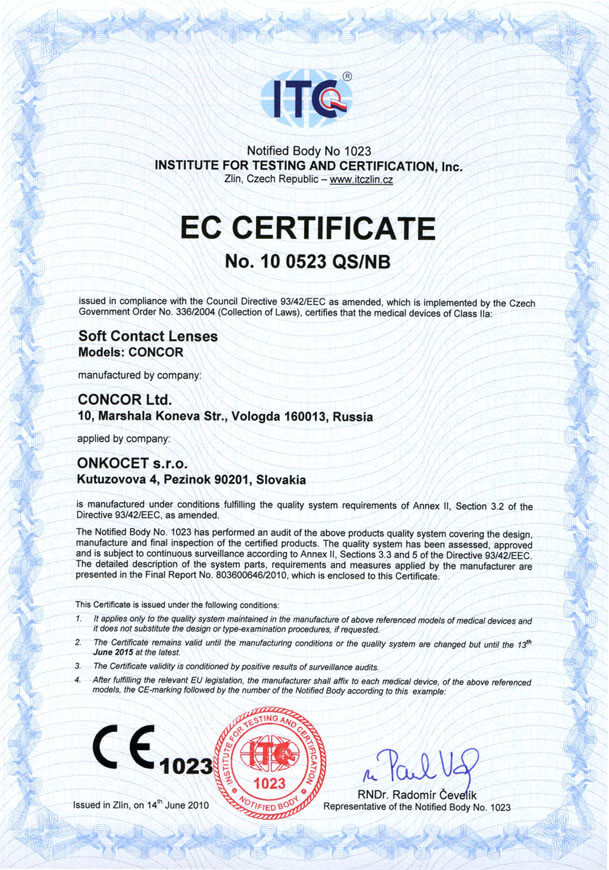 You can find the certificate here.
You can find the certificate here.More information on Concor Soft Contact Lenses go to section Medical preparations/Concor soft contact lenses, or follow this link.
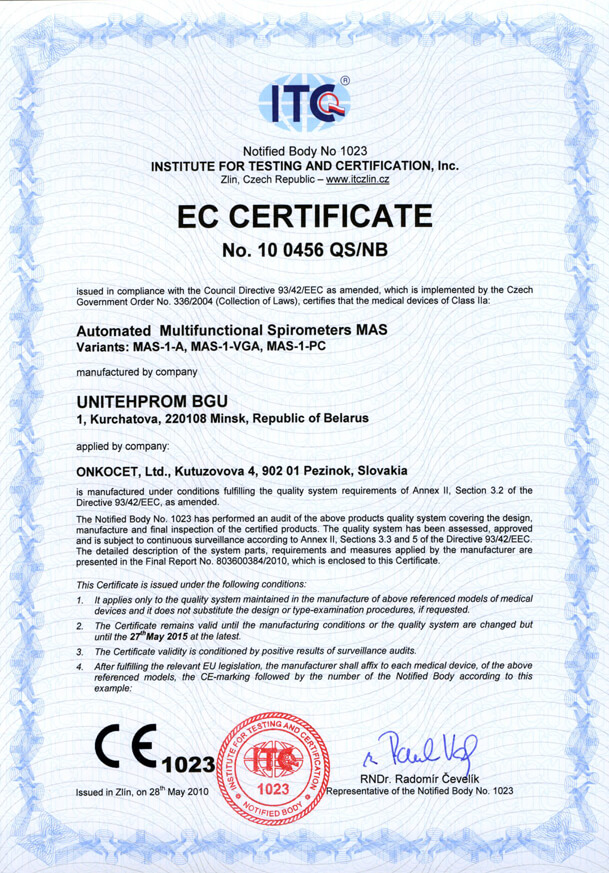 Our company has finished the certification process for another medical device, computerized spirometer MAS-1K with oximeter. You can find the device certificate here.
Our company has finished the certification process for another medical device, computerized spirometer MAS-1K with oximeter. You can find the device certificate here..jpg) Since May 2010 there is a new version of AMP device available.
Since May 2010 there is a new version of AMP device available.Follow this link if you want to see the pictures and specifications of the device.
http://www.onkocet.eu/en/produkty-detail/293/1/
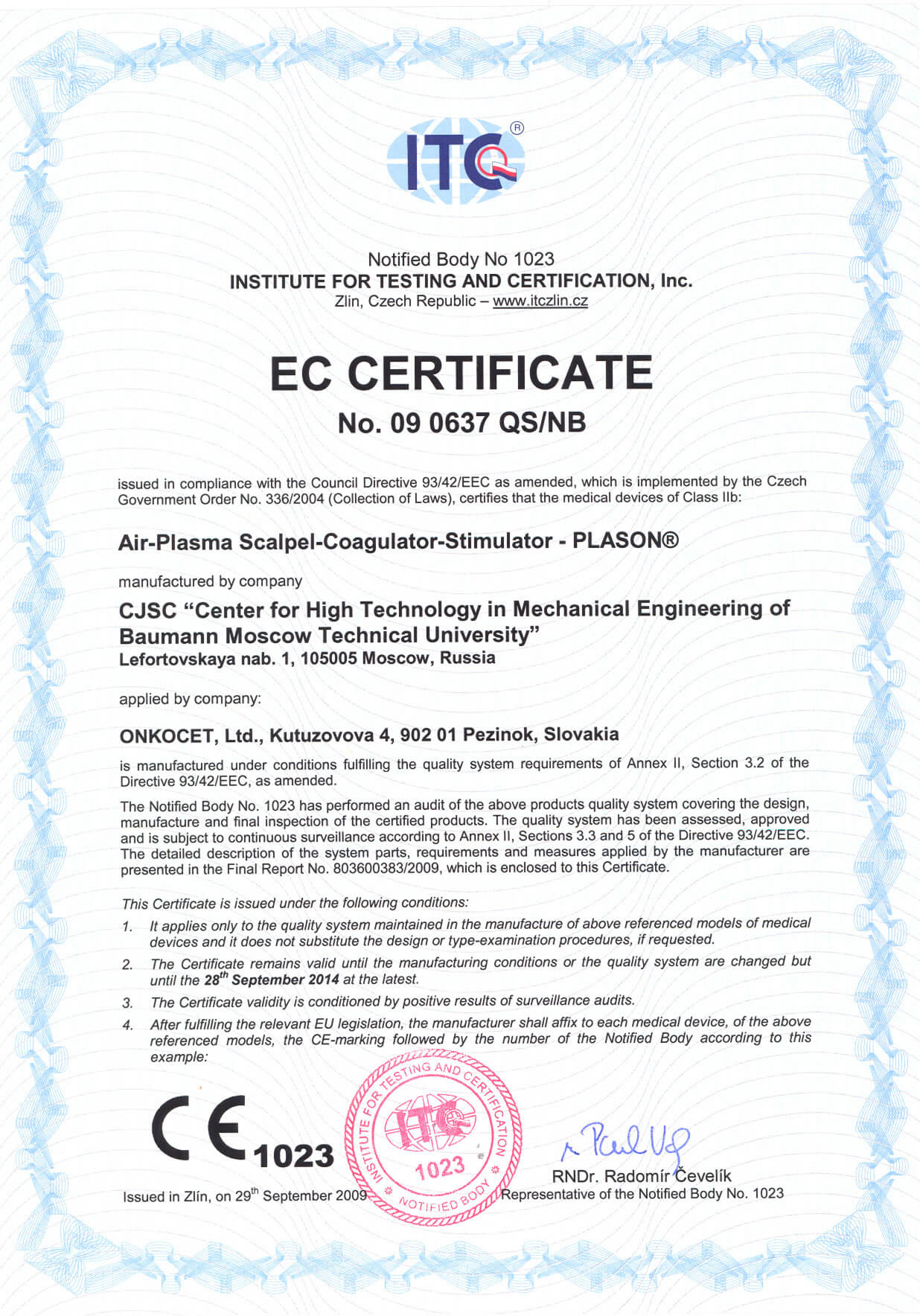 Dear partners,
Dear partners, In October 2009 we have received CE certificate for another device from our portfolio, NO therapeutical device PLASON. You can find more information about this revolutionary device, used for healing of unhealing wounds, diabetic foot, or for cosmetical purposes, at our webpage, section "Medical devices" -> PLASON-NO Therapy.
.gif)
Best regards
Team of ONKOCET Ltd. company
Treatment of tropic ulcers
Application of exogenous NO and air plasma in the treatment of the trophic ulcers of the vascular etiology
Clinical experiments showed the high efficiency of NO- therapy during the treatment of the following widely widespread diseases of peripheral vessels:
1) the chronic venous insufficiency of lower extremities (CVILE), complicated by the formation of trophic defects (the so-called “venous” trophic ulcers);
2) chronic critical ischemia of the lower extremities (CCILE) against the background of the chronic occlusion diseases of the arteries of lower extremities.
The varicose expansion of the hypodermic veins of lower extremities is encountered according to numerous data of the different authors in 15-19,5% of adult population, moreover in 50% of these patients are developed the trophic disorders of the skin of the shins in the form of hyper-pigmentation, paratrophic eczema and paratrophic scleroderma, trophic ulcers. Surgical interventions (removal of the varicose changed hypodermic veins and the bandaging of communication veins) are connected with the high risk of festering operating wounds. By patients with the associated thrombosis of deep veins and with the edematic form of postthrobophlebitis syndrome operational interference apropos of the varicose expansion of hypodermic veins is contraindicated. From what was stated above is obvious the topical character of the problem of the conservative treatment of the trophic disorders of the skin against the background of CVILE. Not less immediate is the problem of the treatment of the trophic ulcers against the background of CCILE, which according to the data of WHO (World Health Organization) is encountered in 2% of population older than 60 years. Among the patients with CCILE the trophic defects of soft tissues are encountered in 20-22%; however, against the background of associated diabetes mellitus the frequency of the appearance of trophic defects comprises not less than 45%.
In the department of the faculty surgery of the 2nd therapeutic department MMA of I.M.Sechenov on the base CMH 61 the clinical experiment is carried out in 119 patients with the venous trophic ulcers of shin in the age from 41 to 82 years. On the basis a clinical and ultrasonic dopplerographic study was revealed, that 46 patients (39%) had the trophic ulcer against the background of the primary varicose expansion of the veins of lower extremities, in 73 (61%) - against the background of postthrombotic disease. Area of trophic ulcers - from 6 to 150 cm2.
Conservative treatment was either the stage of preoperation preparation or the basic version of the treatment in patients, by which the surgical treatment was counter-indicative. For the judgment about the effectiveness of the conservative stage of treatment the clinical and planimetric indices of the course of the process of sanitation and epithelization of ulcer, a bacteriological study of discharge from the ulcer, the cytological study of exudate, a histopathological study of bioptat from boundary trophic ulcer, the indices of microcirculation (according to the data of laser Doppler floumetri - LDF) and of transcutaneous tension of oxygen (TTO), the periods of the readiness of patient for the surgical and phlebosclerotic treatment are used.
The basic group of observations (NO- therapy) composed of 82 patients, distributed into two subgroups: in the I basic subgroup (54 patients) trophic ulcers processed APF (air plasma flow) in the regime of NO- therapy; in the II basic subgroup (28 patients) prior to the beginning of NO- therapy the ulcerous surface finished APF in the regime of coagulation before the evaporation of necrotic detritus and formation of coagulation scab. Further during 15 days the surface of scab was finished in the regime of NO- therapy. Into the group of comparison (proteolytic and antimicrobic preparations - in the phase of exudation and necrosis and stimulators - in the phase of regeneration and epithelization) entered 37 patients.
For the substantiation of the time of the action of the NO- containing gas flow (NO - CGF) per unit of the area of ulcer are used the results of processing trophic ulcer by an area of 12 cm2 for the concentration of NO in the zone of contact of 500 ppm. Each minute of action were taken reading of microcirculation changes by the method LDF. As a result conducted investigation was established that the duration of action on one zone with an area of 2 cm2 must compose 8-10 flogged, and the total time of action - with respect to the area of ulcerous defect.
A quantity of sessions of the therapy by the oxide of nitrogen is determined by the appearance of bright granulations and expressed boundary epithelization.
Optimum time of action by the oxide of nitrogen depending on the area of the trophic ulcers
Area of ulcer, cm2 | 6-30 | 35-55 | 56-80 | 81-105 | 106-130 | 131-155 |
Time of working, min | 0,5-2,0 | 2,0-3,5 | 3,5-5,0 | 5,0-6,5 | 6,5-8 | 8,0-9,5 |
Planimetric observation of the dynamics of the reduction in area of trophic ulcers showed that in the group of comparison the area of ulcer decreased on the average by 0,7% in a 24 hour period, and in the basic group by 1,7% in a 24 hour period. The comparative estimation of the clinical indices of the healing of trophic ulcers in the different groups is represented in the following table.
Comparative estimation of the dynamics of the flow of wound process in the trophic ulcers
Evaluation criteria | Group of comparison, N-37 | The basic group | |
I subgroup N-54 | II subgroup N-28 | ||
Purification from the pathologic exudate, days | 12,3±3,5 | 8,3±3,0 | - |
Regress of the phenomena of perifocal inflammation, days | 11,5±2,1 | 8,4±2,2 | 5,5±1,8 |
Appearance of granulations, days | 15,1±3,6 | 7,6±2,5 | 7,2±2,8 |
Appearance of epithelization, days | 16,7±2,9 | 8,3±1,9 | 8,2±2,3 |
Reduction in area of ulcers, % in 24 hrs | 0,7 | 1,6 | 1,7 |
Allergic dermatitis, % | 29,7 | 22,2 | 25 |
Recurrent festering, % | 0 | 0 | 0 |
In 2,5 months the complete healing of trophic ulcers in the group of comparison is noted in 43% of patients (the reference area of ulcers not more than 30 cm2), in the I subgroup of basic group - in 92% of patients, in the II subgroup of basic group - in 85% of patients, the reference area of trophic ulcers in the patients of these subgroups exceeding 50 cm2 (Fig. 1).
Comparative estimation of the dynamics of the healing of the trophic ulcers
Group of the patients | Area (S) of trophic ulcers, cm2 | Complete healing of trophic ulcers,% | |
21 days | 76 days | ||
Group of comparison, N-37 | S<50; | 0 | 43,2 |
The basic group, I subgroup N-54 | S>50 | 22,2 | 92 |
The basic group, II subgroup N-28 | S>50 | 21,4 | 85,7 |
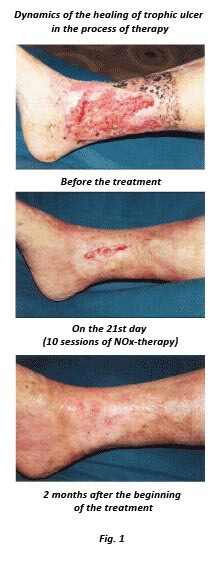 A bacteriological study of wound treatment separable from the trophic ulcers prior to the beginning revealed the poly-microbial nature of flora, been microbial associations with the very weak sensitivity to the antibiotics of the wide spectrum of action. The qualitative and quantitative analysis of the bacterial flora, isolated from the trophic ulcers, showed that in the basic group against the background of NO- therapy, especially in combination with the preliminary coagulation of ulcerous surface, is reduced the degree of bacterial seeding and already to 7-14 days it becomes below the critical level, necessary for maintaining the infectious process in the wound. In the control group an analogous decrease is noted not earlier than 21 days from the beginning of treatment (Fig. 2).
A bacteriological study of wound treatment separable from the trophic ulcers prior to the beginning revealed the poly-microbial nature of flora, been microbial associations with the very weak sensitivity to the antibiotics of the wide spectrum of action. The qualitative and quantitative analysis of the bacterial flora, isolated from the trophic ulcers, showed that in the basic group against the background of NO- therapy, especially in combination with the preliminary coagulation of ulcerous surface, is reduced the degree of bacterial seeding and already to 7-14 days it becomes below the critical level, necessary for maintaining the infectious process in the wound. In the control group an analogous decrease is noted not earlier than 21 days from the beginning of treatment (Fig. 2).
The executed by the method LDF study of microcirculation in the cloths of trophic ulcers prior to the beginning of treatment revealed in all patients its expressed disturbances according to the hyperemic type, that are accompanied by the paretic expansion of micro-vessels, by the stasis of the blood, by the disturbance of venous draining and mechanisms of modulation of woven blood flow (myogenic, neurogenic and respiratory), change in the blood pressure and its regulation, significant reduction in the vasomotor activity of vessels. A simultaneous study of the transcutaneous tension of oxygen on the edges of ulcer of up to the beginning of treatment revealed in all patients significant reduction in this index.
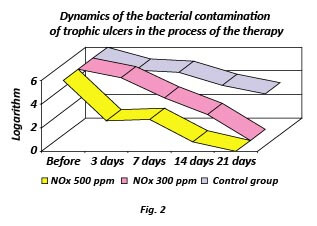
The disorders of microcirculation, caused by intravascular and extravascular changes, served as the reason for local circulatory hypoxia prior to the beginning of treatment.
The normalization of the pathologically changed amplitude-frequency characteristics of microcirculation and the activating of regulator mechanisms was observed after the course of NO- therapy. To 14-18 days the average index of microcirculation (IM), the value of the root-mean-square deviation (RSD), the coefficient of variation (CV) and index of flaksmot microcirculation (IFM) approached in the value indices of the symmetrical sections of healthy shin. In the group the comparisons of the disturbance of microcirculation remained.
Dynamics of the average index of microcirculation (IM) of LDF- grams in the process of the treatment
Groups | Index of the standard | Before the treatment | 3 days | 7 days | 14 days | 21 days |
Group of the comparison | 5,33±0,64 | 25,9±1,5 | 25,1±0,8 | 23,6±1,3 | 19,7±1,1 | 15,8±1,3 |
Basic group - I subgroup | 5,33±0,64 | 25,9±1,5 | 20,3±0,9 | 21,9±1,4 | 14,7±1,2 | 6,14±1,1 |
Basic group - II subgroup | 5,33±0,64 | 25,9±1,5 | 21,1±1,2 | 22,3±1,1 | 11,9±1,3 | 5,54±0,9 |
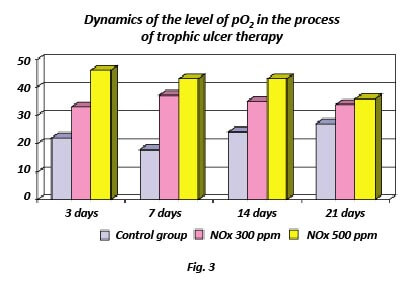 Against the background treatment the normalization of the level of the transcutaneous tension of oxygen (TaO2) in the basic group, especially in the II subgroup, passed more intensively than to the group of comparison (Fig. 3).
Against the background treatment the normalization of the level of the transcutaneous tension of oxygen (TaO2) in the basic group, especially in the II subgroup, passed more intensively than to the group of comparison (Fig. 3).
Histological and histochemical studies of bioptat from boundary ulcer show, that before treatment cloth characterize presence express disorder microcirculation (stasis, sludge and micro-thrombosis), edema, plasmatic impregnation and lymphostasis, suppression phagocytosis, weakness macrophage reaction, chronic inflammatory infiltration, vasculit and pyonecrotic imposition on ulcerous surface (Fig. 4).
The weak proliferating potential and the dystrophia of fibroblasts prevented ripening granulating cloth, which under the conditions of chronic inflammation acquired the features of the defective persisting granulating cloth with the special cellular structure and the tendency toward the second necroses and the hyperergic reactions, braking of epithelization.
IN the I subgroup of basic group with the NO- therapy already in 7 days, in contrast to the group of comparison, occurred the normalization of microcirculatory disturbances, decreased and disappeared the stasis of the blood, sludge of erythrocytes, micro-thrombosis, increased permeability of vessels. The purification of ulcerous surface from the necrotic detrite, the destroyed leukocytes and the bacterial colonies intensively occurred. The stimulation of wound process realized to a considerable degree because of the activation of macrophage reaction and strengthening of an increase in the fibroblasts. Active proliferation and differentiation of the latter from 7 days from the beginning of treatment was stimulated by the straight delivery of the exogenous nitrogen oxide. The proliferation of fibroblasts occurred simultaneously with angiogenesis, which created conditions for an increase in the granulating cloth (Fig. 5).
Biosynthetic activity of fibroblasts was strengthened, which was confirmed by histochemical reactions, increased the synthesis of glycosaminoglycans and collagen, fibrillogenesis and fibrogenesis of collagenic fibers, ripening granulating cloth and subsequent regeneration of the epithelium is synchronous with the purification of the surface of ulcer and the fibrous transformation of cloth. Valuable granulating cloth with the vertical vessels to 14 days already filled ulcerous defect, displacing pathologic granulating cloth and fibrocicatricial tissue “old” ulcers due to the production of collagenasis by macrophages and by fibroblasts. To 21 days on the edges of large ulcers and on the large part of the area of small ulcers occurred the fibrous transformation of granulating cloth and the regeneration of epidermis (Fig. 6).
In the II subgroup with the NO- therapy after the preliminary coagulation of ulcerous surface by high-temperature air- plasma flow the stimulation of the process of wound healing occurred even more intensive. Inflammatory processes were diluted more rapidly under the thin scab because of the destruction of necrotic masses and sterilization of ulcerous surface, and the signs of the disturbance of microcirculation decreased because of the therapy by the nitrogen oxide. The proliferation of fibroblasts and angiogenesis to 7 days they already conducted to shaping of granulating cloth with the vertical vessels, which ripened to 14 and was fibrosed to 21 days. Boundary epithelization was accelerated and in the majority of the cases to 21 days the scars were shut.
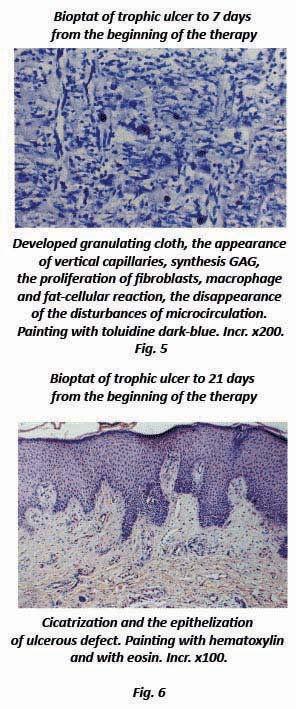 The clinical experiments of the effectiveness of the NO- therapy of the trophic ulcers of the shin of venous and arterial genesis was carried out also in the division of surgery of vessels and angiosexology NIT MMA i.n. I.M.Sechenov on the base CMH 7. NO- therapy was used for the treatment “venous” ulcers in 154 patients in the age from 46 to 62 years. In all patients it took place of CVILE which was complicated by the formation of trophic ulcers, of them in 15 were the edematic form of posttromboflebetic syndrome (PTFS) with reduction in the passability over the deep veins. The duration of existence of trophic ulcers up to the moment of hospitalization variable from 1 to 36 months. The size of ulcers was from 2 to 7 cm in the diameter. During the duplex scanning of veins was evaluated the passability of deep veins, the presence or the absence of the insufficiency of the valve apparatus of the deep and communication veins of lower extremities.
The clinical experiments of the effectiveness of the NO- therapy of the trophic ulcers of the shin of venous and arterial genesis was carried out also in the division of surgery of vessels and angiosexology NIT MMA i.n. I.M.Sechenov on the base CMH 7. NO- therapy was used for the treatment “venous” ulcers in 154 patients in the age from 46 to 62 years. In all patients it took place of CVILE which was complicated by the formation of trophic ulcers, of them in 15 were the edematic form of posttromboflebetic syndrome (PTFS) with reduction in the passability over the deep veins. The duration of existence of trophic ulcers up to the moment of hospitalization variable from 1 to 36 months. The size of ulcers was from 2 to 7 cm in the diameter. During the duplex scanning of veins was evaluated the passability of deep veins, the presence or the absence of the insufficiency of the valve apparatus of the deep and communication veins of lower extremities.
To the patients of basic group was conducted NO- therapy with the use of an apparatus “PLASON”. Treatment consisted of the daily working of the region of ulcer NO- CGF during the 2nd minutes. They moved away mechanically when there is dry scab at the ulcer present. Dry sterile bandage was superimposed at the end of procedure on the ulcer. The duration of the course of NO- therapy amounted on the average to on 15 days.
For the objectivization of a study the group of comparison of 54 patients with the analogous trophic ulcers, which obtained the usual treatment (bandages with antiseptics and stimulators of woven increase, physiotherapy, elastic compression the like), was formed. The general state of patients, the duration of basic disease, and also gravity of trophic defects were similar. The effectiveness evaluation criteria for action exogenous NO were: the dynamics of inflammatory process, the forming of granulating cloth and the epithelization of trophic defects.
The granulations in the trophic defects were absent prior to the beginning of treatment in 79,5% of patients or they were very sluggish. The presence of fibrinonecrotic impositions is noted in the overwhelming majority of patients (85,5%) in the trophic ulcers. In 81,8% of patients against the background of NO- therapy occurred the complete healing of trophic defects, in 13,6% of patients - their decrease and the regress of periulcerous dermatitis, in 4,5% of patients trophic defects proved to be resistance to the NO- therapy. In this case in 100% of cases the purification of the surface of ulcerous defects from the fibrinonecrotic detrite is noted. The absence of an increase in the microflora was noted during the control bacteriological sowings from the ulcers onto 5-7 days after the beginning NO-therapy in 93,2% of patients. The time of purification and healing of trophic defects in the basic group was reliably lower than in the group of comparison - 15,2±3,0 of the day in the basic group and of 21,6±2,0 in the group of comparison. The periods of observation of the patients, who transferred NO- therapy, were from 1 months of hospital period to year.
Any side effects from the application of a new procedure in the distant period (to the year) were not noted.
In parallel with these studies was conducted the study of the effectiveness of the NO- therapy of trophic ulcers with chronic critical ischemia of the lower extremities (CCILE) against the background of the chronic occlusion diseases of arteries (“arterial” ulcers).
The basic group of observations they composed 68 patients at the age from 56 to 72 years, which suffer CCILE, which was complicated by the formation of trophic ulcers with the preferred localization on the foot. In 39,3% vascular pathology was combined with uncompensated diabetes mellitus. The period of the chronic occlusion disease of arteries composed from 1 year to 8 years, period of CCILE - from the 2nd weeks to 2,5 months. Period of the appearance of trophic ulcers on the skin of shin to the moment of the hospitalization varies from 1 to 2 months. The size of ulcers was from 1 to 5 cm in the diameter. During the duplex scanning of arteries their passability, extent of the occlusion- stenotic defeat of arterial bed was evaluated.
The procedure of NO- therapy is analogous to that described above. Duration of application - 15-25 days. Clinical effect was evaluated at the end the course of therapy.
In 35,7% of patients against the background NO-therapy occurred the complete healing of trophic defects, in 33,6% - their decrease, but final healing it did not begin. In remaining patients, as a rule with associated heavy diabetes mellitus, trophic defects proved to be resistance to the NO- therapy.
Thus, the NO- therapy of trophic ulcers both in the patients with the chronic venous insufficiency of lower extremities and with the occlusion diseases of arteries gives the expressed effect in the overwhelming majority of the cases: (more than 80% “venous” and more than 65% “arterial” ulcers), it is considerable (doubly) accelerating their healing and drawing near the periods of the fulfillment of operational interference. The preliminary coagulation of ulcerous surface by air plasma with the subsequent NO- therapy even more improves the results of treatment, making it possible from 3 days to already carry out flebectomy or flebosclerosation.
Note: Bioptat – material from biopsy
